|
|
 |
Jose Antolinez
|
|
Spanish Baroque Era Painter, 1635-1675
was a Spanish painter of the Baroque period. Antolinez's early training as a landscape artist may have been under Iriarte. Later, when he moved to the court in Madrid, he entered the studio of Francisco Rizi. His '"haughty character and sarcastic personality gained him many enemies among his contemporaries". Some note he played maddening jokes on his colleagues Claudio Coello and Cabezalero as well as Itizi, whom he called painter of wall ornaments, in allusion to the latter's decoration of the hall of comedies in the Palace of Buen Retiro |
|
|
|
 |
Jose Ferraz de Almeida Junior
|
|
(8 May 1850 - 13 November 1899) was a Brazilian painter of the 19th century. He is widely regarded as the most important Brazilian realist painter of the 19th century, and a major inspiration for the modernist painters. While most Brazilian academic artists made their fame painting mythological or historical subjects, Almeida Junior would become popular for painting rural figures, especially farmers and the caipira violeiro , the countrymen that are a kind of a symbol of the rural areas of the São Paulo state.
While most realist painters used farmers and countrymen as an allegory of workers, Almeida Junior would paint his caipiras mostly on leisure time. He would also produce touching images of upscale landowners. The Bandeirantes, the ruthless explorers of colonial Brazil, would be depicted in the A partida da monção, showing an expedition on the Tiete River.
Almeida Junior was born in the city of Itu, then a small town in the state of São Paulo. After becoming a sensation in his town he would be invited to study in the Brazilian Imperial Fine Arts Academy of Rio de Janeiro, but in 1876 would study in France after being granted a scholarship by emperor Pedro II of Brazil in person in the city of Moji-Mirim. He would have Alexandre Cabanel as one of his masters. In 1877 he was already enrolled in the School of Fine Arts in Paris. He took part at the Salon de Paris with several works of art in 1879 (Retrato do Dr. Jose de Magalhães), 1880 (O Derrubador Brasileiro) and (Remorso de Judas), 1881 (Fuga para o Egito) and 1882 (Descanso do Modelo) He admired the French realist and naturalist painting (a major influence at his work), and, after returning to Brazil in 1882, became of the leading names in Brazilian realist painting.
He was stabbed to death by the husband of his mistress on November 13, 1899 in Piracicaba.
|
|
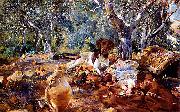 |
Jose Jimenez Aranda
|
|
(February 7, 1837 - May 6, 1903) was a Spanish painter.
Persondata
Name Jimenez Aranda, Jose
Alternative names
Short description
Date of birth February 7, 1837
Place of birth
Date of death May 6, 1903
Place of death
|
|
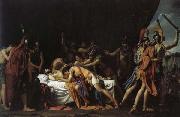 |
jose Madrazo Y Agudo
|
|
Spanish Neoclassical Painter, 1781-1859
was a Spanish painter of the Neoclassic period. Born in Santander. Studied in Madrid with Cosme de Acuna and Gregorio Ferro, both rectors of the Academia de San Fernando at the beginning of the 19th century. Don Fernando La Serna, who was named ambassador to France at the time, brought Madrazo to Paris, where he entered the studio of Jacques-Louis David. There, under royal patronage from King Carlos IV, he executed a painting of the Death of Lucretia and other canvases on events from classic Greco-Roman history. He moved to Rome during Napoleonic times, where he was briefly jailed for failing to complete oaths of loyalty to the newly installed Napoleon II of France as King of Rome. In Rome, he was admitted to the Accademia di San Luca. King Carlos IV named him pintor de camara (painter of the chamber), a position confirmed by King Ferdinand VII. |
|
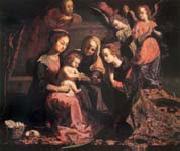 |
Josefa of Ayala
|
|
1630-1684,Portuguese painter and engraver. She was the daughter of the Portuguese painter Baltazar Gomes Figueira (1597-1674) and a Spanish lady, Doea Catarina de Ayala y Cabrera. After the restoration of the Portuguese monarchy in 1640 the family moved to Coimbra. Here Josefa began her apprenticeship under her father, a painter of landscapes, still-lifes and religious works, who in 1644 painted the retable of Nossa Senhora da Graea, Coimbra, in the naturalist-tenebrist style he had learnt in Seville in the circles of Juan del Castillo, |
|
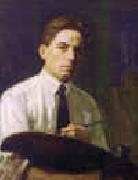 |
Joseph A Kleitsch
|
|
1885-1931
Joseph Kleitsch (1885-1931) was an American painter who holds a high place in the early California School of Impressionism. Born in Banad, Hungary on June 6th, 1885, young Joseph Kleitsch was drawn to paint at the early age of seven, he later pursued his professional art training at Budapest, Munich and Paris. Influenced by his visits to the famous museums of Europe, Kleitsch continued with his love of portrait and figuritive painting after relocating to California. There he rose to the challenge of capturing his new environment's brilliant light and diverse landscape. Living in Los Angeles for a while, Kleitsch fell in love with the rustic artist village of Laguna Beach. There he painted the town's eucalyptus lined streets, the crashing waves of the Pacific coastline and the nearby Mission San Juan Capistrano. Arthur Millier of the Los Angeles Times in 1922 was quoted saying of Kleitsch "he was a born colorist; he seemed to play on canvas with the abandon of a gypsy violinist". Joseph Kleitsch died at the age of forty-nine in Santa Ana, California on November 16th, 1931. |
|
|
|
|
|
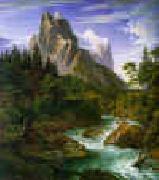 |
Joseph Anton Koch
|
|
1768-1839
Austrian
Joseph Anton Koch Galleries
was an Austrian painter of the German Romantic movement. The Tyrolese painter left academic training in the Karlsschule Stuttgart, a strict military academy, and traveled through France and Switzerland. He arrived in Rome in 1795. Koch was close to the painter Asmus Jacob Carstens and carried on Carstens' 'heroic' art, at first in a literal manner.
After 1800 Koch developed as a landscape painter. In Rome he espoused a new type of 'heroic' landscape, revising the classical compositions of Poussin and Lorrain with a more rugged, mountainous scenery. He left Rome in 1812 and stayed in Vienna until 1815, in protest of the French invasion. During this period he incorporated more non-classical themes in his work. In Vienna he was influenced by Friedrich Schlegel and enthusiasts of old German art. In response, his style became harsher, and this new approach had a wide influence on German landscape painters who visited Rome. |
|
|
|
 |
Jost Amman
|
|
(June 13, 1539, Zerich - March 17, 1591, Nuremberg, Bavaria) was a Swiss artist, celebrated chiefly for his woodcuts, done mainly for book illustrations.
Amman was born in Zurich, the son of a professor of Classics and Logic. He was himself well-educated. Little of his personal history is known beyond the fact that he moved to Nuremberg in 1560, where he continued to reside until his death in March 1591. He worked initially with Virgil Solis, then a leading producer of book illustrations. His productiveness was very remarkable, as may be gathered from the statement of one of his pupils, that the drawings he made during a period of four years would have filled a hay wagon. A large number of his original drawings are in the Berlin print room. About 1,500 prints are attributed to him. He was one of the last major producers of woodcuts for books, as during his career engravings were gradually taking over that role. Although like most artists for woodcut he normally let a specialist formschneider cut the block to his drawing, he sometimes included both a cutter's knife and a quill pen in his signature on prints, suggesting he sometimes cut his own blocks.
A series of engravings by Amman of the kings of France, with short biographies, appeared in Frankfurt in 1576. He also executed many of the woodcut illustrations for the Bible published at Frankfurt by Sigismund Feierabend. Another serial work, the Panoplia Omnium Liberalium Mechanicarum et Seden-tariarum Artium Genera Continens, containing 115 plates, is of great value. Amman's drawing is correct and spirited, and his delineation of the details of costume is minute and accurate. Paintings in oil and on glass are attributed to him, but none have been identified.
|
|
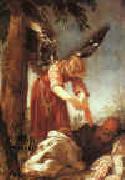 |
Juan Antonio Escalante
|
|
Spanish Baroque Era Painter, 1633-1670
Spanish painter. He was an outstanding figure in decorative Baroque art. When quite young he moved from Andalusia to Madrid, where he apparently worked with and was influenced by Francisco Rizi. His artistic development reveals an increasing admiration for Veronese, Tintoretto and Titian, although elements of the style of Alonso Cano persist. Among his first works is Andromeda and the Dragon (c. 1659; Madrid, Prado), whose mannerist elements derive from an engraving of the subject by Agostino Carracci. The two brilliant works St Catherine of Alexandria (Madrid, Las Maravillas) and Road to Calvary (Madrid, Real Acad. S Fernando), signed and dated 1660, are executed with an agile and self-assured technique, in colours that stem from Venetian painting. Like other Spanish painters of the period, he painted numerous versions of the Immaculate Conception (e.g. 1660, Colegio de Villafranca de los Barros; 1663, Budapest, Mus. F.A.; c. 1666, Benedictine monastery of Lumbier, Navarre), which are more Baroque in style and expression than those of Jose Antolenez and Mateo Cerezo. In these the faces, surrounded by luxuriant hair, is expressed an innocent candour that contrasts with the turbulent appearance of the cherubs. Also characteristic of his style are the versions of the Annunciation (1653; New York, Hisp. Soc. America Mus; B?ziers, Mus. B.-A.). He treated the theme of St Joseph with great nobility, as in the Dream of St Joseph (1666; New York, Chrysler Col.). His deep lyrical feelings pervade the various paintings of the Infant St John (Madrid, Prado). |
|
 |
Juan Antonio Ribera Y Fernandez
|
|
1779-1860
was a Spanish painter, born at Madrid. He first studied under Francisco Bayeu and enrolled into the Royal Academy of San Fernando, but afterwards went to Paris and become the pupil of Jacques-Louis David. There he painted his Cincinnatus which is now in the Prado Museum. In course of time he went to Rome, and in 1811 was appointed painter to Carlos IV and member of the Academy of St. Luke; and in 1820, honorary member of the Academy of San Fernando. In 1838 he was made professor, and two years afterwards Director of the Prado. He died at Madrid. |
|
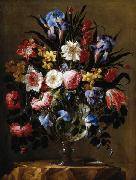 |
Juan de Arellano
|
|
(3 August 1701 - 13 October 1776) was a Spanish painter of the Baroque era who specialized in floral still life paintings.
Born in Santorcaz, near Madrid, where he died. He was a pupil of Juan de Solis. Heavily influenced by Flemish and Italian painters (such as Mario Nuzzi), Juan de Arellano was considered to be exceptional in this thematic. According to one of his colleagues, de Arellano decided to focus exclusively on floral paintings because it offered more pay while requiring less work . Some of de Arellano's most famous pieces include Bouquet of Flowers (c.1660), and Garland of Flowers, Birds and Butterfly, currently on display at the Louvre. He also painted for the sacristy of the church of San Jerenimo el Real of Madrid. See Bodegen for a description of one style of Spanish still life painting. |
|
|
|
|
|
|
|
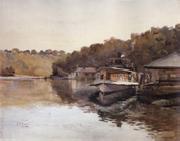 |
Julian Ashton
|
|
Australian Painter, 1851-1942
was an Australian artist and teacher, known for his support of the Heidelberg School and for his influential art school in Sydney. Ashton was born in Addlestone, Surrey, England and arrived in Australia in 1878 with a background in the contemporary French realism of the Barbizon School, which emphasised painting en plein air (i.e. direct from nature, as opposed to studio-based painting), and which laid the basis for the Impressionist movement. As a trustee of the Art Gallery of New South Wales he championed emerging Australian artists of the Australian Impressionist or Heidelberg School, and the Gallery's decision to collect these works owes much to his influence. According to James Gleeson, Ashton's oil paintings, much-admired in his own lifetime, |
|
|
|
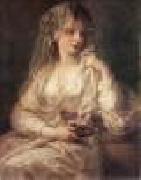 |
KAUFFMANN, Angelica
|
|
Swiss Neoclassical Painter, 1741-1807
Swiss-born Italian painter. She began studying art in Italy as a child, showing great precocity, and in 1766 her friend Joshua Reynolds took her to London. There she became known for her decorative work with architects such as Robert Adam. Her pastoral compositions incorporate delicate and graceful depictions of gods and goddesses; though her paintings are Rococo in tone and approach, her figures are Neoclassical (see Classicism and Neoclassicism). Her portraits of female sitters are among her finest works. |
|
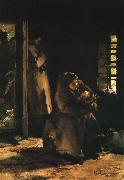 |
Kazimierz Alchimowicz
|
|
(1840 ?C 1916) was a Lithuanian-born Polish romantic painter.
Born in Dziembrow, Lithuania, Alchimowicz was banished to Siberia for six years for his participation in the January Uprising. After his return, he enrolled in a drawing class in Warsaw taught by Wojciech Gerson. The class had a great influence on his later artistic works. He later studied art in Munich, Germany and Paris, France. While staying in France, Alchimowicz was a craftsmen decorating porcelain and earthenware crafts. He settled permanently in Warsaw in 1880 to paint professionally. His artistic inspiration mainly came from patriotic topics and history. |
|
 |
KEIRINCKX, Alexander
|
|
Flemish painter (b. 1600, Antwerpen, d. 1652, Amsterdam).
Flemish painter. He was the son of Matthijs Keirinckx and Anna Masson. In 1619 he became a master in Antwerp's Guild of St Luke, he married Clara Matthausen on 18 June 1622, and in 1624 he took on Artus Verhoeven as an apprentice. From 1636 onwards he is regularly recorded in Amsterdam, where he was registered as a citizen in the year of his death. He visited Great Britain, possibly in 1625 (Walpole mentions two signed and dated drawings of London views from this year) and definitely in 1640-41, when he undertook commissions from King Charles I to paint views of royal castles and palaces. |
|
 |
KEY, Adriaan
|
|
Flemish painter (b. ca. 1544, Antwerpen, d. after 1589, Antwerpen). |
|
|
|
|
|
|
|
|
|
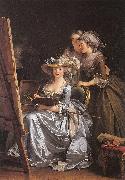 |
Labille-Guiard, Adelaide
|
|
French Neoclassical Painter, 1749-1803
French painter. Labille-Guiard was a painter of the French nobility before the Revolution and survived to paint the citizens of the Directory. Emerging from the 18th-century tradition of powdered wigs and shimmering satins, she captured informal moments in the lives of her subjects, frequently depicting them interrupted from some pastime |
|
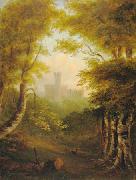 |
Lady Anne Barnard
|
|
(12 December 1750-6 May 1825), nee Anne Lindsay, eldest daughter of James Lindsay, 5th Earl of Balcarres was born at Balcarres House, Fife, Scotland. She was author of the ballad Auld Robin Gray and an accomplished travel writer, artist and socialite of the period. Her five year residence in Cape Town, South Africa, although brief, had a significant impact on the cultural and social life of the time. |
|
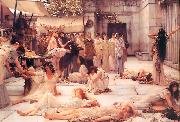 |
Laura Theresa Alma-Tadema
|
|
(1852 C 15 August 1909 in Hindhead) was from 1871 the second wife of the painter Lawrence Alma-Tadema and a painter in her own right.
A daughter of Dr George Napoleon Epps (who was brother of Dr John Epps), her two sisters were also painters (Emily studied under John Brett, a Pre-Raphaelite, and Ellen under Ford Madox Brown), whilst Edmund Gosse and Rowland Hill were her brothers-in-law. It was at Madox Brown's home that Alma-Tadema first met her in December 1869, when she was aged 17 and he 33. (His first wife had died in May that year.) He fell in love at first sight,and so it was partly her presence in London (and partly the fact that only in England had his work consistently sold) that influenced him into relocating in England rather than elsewhere when forced to leave the continent by the outbreak of the Franco Prussian War in July 1870. Arriving in London at the beginning of September 1870 with his small daughters and sister Artje, Alma-Tadema wasted no time in contacting Laura, and it was arranged that he would give her painting lessons. During one of these, he proposed marriage. As he was then thirty-four and Laura was now only eighteen, her father was initially opposed to the idea. Dr Epps finally agreed on the condition that they should wait until they knew each other better. They married in July 1871 and, though this second marriage proved childless, it also proved enduring and happy, with Laura acting as stepmother to her husband's children by his first marriage.
The Paris Salon in 1873 gave Laura her first success in painting, and five years later, at the Paris International Exhibition, she was one of only two English women artists exhibited. |
|
|
|
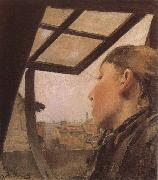 |
Laurits Andersen Ring
|
|
Danish, 1854-1933
Laurits Andersen Ring (1854-1933) was one of the foremost painters of Danish symbolism. He was born as Laurits Andersen in the village Ring in southern Zealand. In 1881 he the took the name of his birth place, and was since known as L.A. Ring.
For a while, he lived at Baldersbronde near Hedehusene in the old school building, which was later to be the home of another painter, Ludvig Find. Ring has produced several paintings from these towns.
As a painter, he never distanced himself from his humble origin, but rather made it his dominant theme. Most of his paintings depict the village life and landscapes of southern Zealand from Præsto to Nestved. There are several examples of his work at practically every Danish art museum including the Hirschsprung Collection in Copenhagen.
He was married on July 25, 1896 to fellow painter Sigrid Kahler, who was the daughter of ceramic artist Herman Kahler. |
|
 |
Legros, Alphonse
|
|
French-born British Painter and Sculptor, 1837-1911
British etcher, painter, sculptor and teacher of French birth. He is said to have been apprenticed at the age of 11 to a sign-painter, at which time he may also have attended classes at the Ecole des Beaux-Arts in Dijon. He was employed as assistant on a decorative scheme in Lyon Cathedral before moving in 1851 to Paris, where he worked initially for the theatre decorator C. A. Cambon (1802-75). He soon became a pupil of Horace Lecoq de Boisbaudran, whose methodical instruction and liberality in fostering individual talent proved of lasting benefit to Legros. In 1855 he enrolled at the Ecole des Beaux-Arts, Paris, attending irregularly until 1857. During this period Legros had a taste for early Netherlandish art and for French Romanticism, which was later superseded by his admiration for Claude, Poussin and Michelangelo. |
|
 |
Lemuel Francis Abbott
|
|
1760-1803
Lemuel Francis Abbott Locations
English painter. He was the son of a clergyman and went to London to study with Francis Hayman shortly before the latter death in 1776; he may have completed his studies in Derby with Joseph Wright of Derby. By the early 1780s Abbott had established a busy portrait practice in London. The formula he adopted for most of his head-and-shoulder portraits can be seen in Sir William Herschel (1785; London, N. Mar. Mus.): the body is parallel to the picture plane, and the sitter head is moved into three-quarter profile, as if his attention has been suddenly distracted. In later portraits, such as those of fellow artists Francesco Bartolozzi (c. 1792; London, Tate) or Joseph Nollekens (c. 1797; London, N.P.G.), the sitter hand or some attribute balances the movement of the head. Only male portraits by Abbott are known, and his patrons were mostly drawn from the professional classes, particularly the Navy; there are several versions of Lord Nelson (e.g. 1798; London, N. Mar. Mus.). His style is crisp but scratchy in technique, and often the anatomy of his figures is inaccurate. Paint is handled in a manner comparable with that of Gainsborough Dupont, but Abbott sense of composition is superior. In 1798 he was certified insane, but he continued to exhibit at the Royal Academy in London for two further years. Several of his works were probably finished by another hand. |
|
 |
LENS, Andries Cornelis
|
|
Flemish painter (b. 1739, Antwerpen, d. 1822, Bruxelles).
Flemish painter and writer. He was the son of the flower painter Cornelis Lens (d after 1766) and studied first under Charles Ykens II (1719-53) and then under Balthazar Beschey. In 1756 he was awarded first prize at the Academie of Antwerp and in 1763 was appointed to the staff on the strength of his decoration (destr.) of the refectory of the Alexians at Lier. He also came to the attention of Charles Alexandre, Duke of Lorraine and Bar, Governor-General of the Netherlands |
|
 |
Lentulov, Aristarkh
|
|
Russian Painter, 1882-1943
Russian painter. He studied art in Penza (1897-1903), Kiev (1903-5), and in St Petersburg (1906) under Dmitry Kardovsky. He participated in major exhibitions, including The Wreath (1907-8), The Link (1908) and Union of Russian Artists (1910). He was a founder-member in 1910 of the avant-garde exhibiting society the JACK OF DIAMONDS |
|
 |
Leon Augustin Lhermitte
|
|
(1844 - 1925) was a French realist painter and etcher whose primary subject matter was of rural scenes depicting the peasant worker.
He was born in Mont-Saint-Pere. A student of Lecoq de Boisbaudran, he gained recognition after his show in the Paris Salon in 1864.
His many awards include the French Legion of Honour (1884) and the Grand Prize at the Exposition Universelle in 1889. Lhermitte died in Paris in 1925.
Lhermittees innovative use of pastels won him the admiration of his contemporaries. Vincent Van Gogh wrote that eIf every month Le Monde Illustre published one of his compositions ... it would be a great pleasure for me to be able to follow it. It is certain that for years I have not seen anything as beautiful as this scene by Lhermitte ... I am too preoccupied by Lhermitte this evening to be able to talk of other things.e
Lhermitte's etchings and paintings are housed in museums around the world including Boston, Washington, Chicago, Montreal, Brussels, Rheims, Paris, Moscow and Florence.
|
|
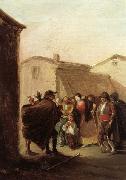 |
Leonardo Alenza Y Nieto
|
|
b Madrid, 6 Nov 1807; d Madrid, 30 June 1845
Spanish painter and illustrator. He studied at the Real Academia de S Fernando, Madrid, under Juan Antonio Ribera y Fern?ndez and Jos? de Madrazo y Agudo. He worked independently of court circles and achieved some fame but nevertheless died in such poverty that his burial was paid for by friends. He is often described as the last of the followers of Goya, in whose Caprichos and drawings he found inspiration for the genre scenes for which he became best known. Of these scenes of everyday life and customs the more interesting include The Beating (Madrid, Cas?n Buen Retiro) and Galician with Puppets (c. 1835; Madrid, Cas?n Buen Retiro; see SPAIN, fig. 17). Alenza y Nieto's numerous drawings include the illustrations for Alain-Ren? Lesage's Gil Blas (Madrid, 1840), for an edition of the poems of Francisco de Quevedo published by Castello and for the reviews Semanario pintoresco and El Reflejo. The painting Triumph of David |
|
 |
Leonor de Almeida Portugal
|
|
Leonor de Almeida Portugal de Lorena e Lencastre (Lisboa, 31 de outubro de 1750 - Benfica, 11 de outubro de 1839) foi uma nobre e poetisa portuguesa. |
|
|
|
|
|
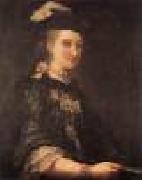 |
LONGHI, Alessandro
|
|
Italian painter, Venetian school (b. 1733, Venezia, d. 1813, Venezia).
Painter, engraver and writer, son of (1) Pietro Longhi. He must have received his first artistic training from his father, although the only evidence of this is the similarity of their styles. He was apprenticed to Giuseppe Nogari, one of the better Venetian portrait painters of the first half of the eighteenth century, and his earliest works are bust-length, mostly life-size portraits in Nogari's style. He first exhibited in 1757 and by 1758 must have been considered a reasonably established artist, |
|
|
|
|
|
 |
Losenko, Anton
|
|
Russian Painter, 1737-1773
Ukrainian painter, active in Russia. He trained (1753-8) under Ivan Argunov, and from 1758 he was a student at the recently founded Academy of Art in St Petersburg, where he later taught. From 1760 to 1769 he spent time in Paris, where he studied at the Acad?mie Royale de Peinture et de Sculpture under Jean Reteux (1692-1768) and Joseph-Marie Vien. He then studied in Rome. |
|
|
|
 |
Louis Anquetin
|
|
1861-1932,French painter. He came to Paris in 1882 and studied art at the Ateliers of Bonnat and Cormon, where he was a contemporary and friend of Henri de Toulouse-Lautrec, Emile Bernard and Vincent van Gogh. His early work shows the influence of Impressionism and of Edgar Degas. In 1887 Anquetin and Bernard devised an innovative method of painting using strong black contour lines and flat areas of colour; Anquetin aroused much comment when he showed his new paintings, including the striking Avenue de Clichy: Five O'Clock in the Evening (1887; Hartford, CT, Wadsworth Atheneum) at the exhibition of Les XX in Brussels and at the Salon des Independants in Paris in 1888. The new style, dubbed Cloisonnisme by the critic Edouard Dujardin (1861-1949), resulted from a study of stained glass, Japanese prints and other so-called 'primitive' sources; it was close to the Synthetist experiments of Paul Gauguin and was adopted briefly by van Gogh during his Arles period. Anquetin's works were shown alongside Gauguin's and Bernard's at the Caf? Volpini exhibition in 1889, |
|
|
|
 |
Louis Gallait
|
|
(9 or 10 May 1810 - 20 November 1887) was a Belgian painter. His d his reputation especially with the large painting of Charles V's abdication. Gallait's works were considered as the basis for a desirable renewal of historical paintings because of the realism, costume faithfulness and colorful posture of his paintings. His last artwork was sent on tour in Germany and that led to new signals even among German historians. He was also a distinguished portrait painter.
Gallait died in Brussels in 1887. There is a painting by Louis Gallait at the Norton Art Museum in West Palm Beach, Florida ("Art and Liberty").
|
|
|

